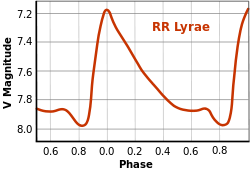RR Lyrae is a variable star, located near the border with the neighboring constellation of Cygnus.
As the brightest star in its class, it became the eponym for the RR Lyrae variable class of stars and it has been extensively studied by astronomers. Several times as many RR Lyraes are known as all Cepheids combined; in the 1980s, about 1900 were known in globular clusters. Some estimates have about 85000 in the Milky Way. Wikipedia
RR Lyrae variables
RR Lyrae variables serve as important standard candles that are used to measure astronomical distances.
The period of pulsation of an RR Lyrae variable depends on its mass, luminosity and temperature, while the difference between the measured luminosity and the actual luminosity allows its distance to be determined via the inverse square law. Hence, understanding the period-luminosity relation for a set of local RR Lyrae-type variable stars allows the distance of more distant stars of this type to be determined.
Williamina Fleming (1857-1911)
Found Horsehead Nebula 1888
image Wikimedia
The variable nature of RR Lyrae was discovered by the Scottish astronomer Williamina Fleming at Harvard Observatory in 1901.
The distance of RR Lyrae remained uncertain until 2002 when the Hubble Space Telescope's Fine Guidance Sensor was used to determine the distance of RR Lyrae within a 5% margin of error, yielding a value of 854 light-years (262 parsecs).
When combined with measurements from the Hipparcos satellite and other sources, the result is a distance estimate of 860 ly (260 pc).
Wikipedia
Pulsating horizontal branch star
 |
| "HR-diag-instability-strip" by Rursus - Own work. Licensed under CC BY-SA 3.0 via Commons |
RR Lyrae type of low-mass star has consumed the hydrogen at its core, evolved away from the main sequence, and passed through the red giant stage. Energy is now being produced by the thermonuclear fusion of helium at its core, and the star has entered an evolutionary stage called the horizontal branch (HB).
The effective temperature of an HB star's outer envelope will gradually increase over time. When its resulting stellar classification enters a range known as the instability strip—typically at stellar class A—the outer envelope can begin to pulsate.
RR Lyrae shows just such a regular pattern of pulsation, which is causing its apparent magnitude to vary between 7.06–8.12 over a short cycle lasting 0.56686776 days (13 hours, 36 minutes). Each radial pulsation causes the radius of the star to vary between 5.1 and 5.6 times the Sun's radius.
This star has a low abundance of elements other than hydrogen and helium—what astronomers term its metallicity. It belongs to the Population II category of stars that formed during the early period of the Universe when there was a lower abundance of metals in star-forming regions.
The trajectory of this star is carrying it along an orbit that is close to the plane of the Milky Way, taking it no more than 680 ly (210 pc) above or below this plane. The orbit has a high eccentricity, bringing RR Lyrae as close as 6.80 kly (2.08 kpc) to the Galactic Center at periapsis, and taking it as far as 59.9 kly (18.4 kpc) at apapsis.
Wikipedia
Blazhko effect
 |
| "Rr lyrae ltcrv en" by RJHall - Own work. Licensed under CC BY-SA 3.0 via Commons |
RR Lyrae belongs to a subset of RR Lyrae-type variables that show a characteristic behavior called the Blazhko effect, named after Russian astronomer and member of Soviet Academy of Sciences, Sergey Blazhko (1870 - 1956).
This effect is observed as a periodic modulation of a variable star's pulsation strength or phase; sometimes both. It causes the light curve of RR Lyrae to change from cycle to cycle. As of 2009, the cause of this effect is not yet fully understood. The Blazhko period for RR Lyrae is 39.1 ± 0.3 days.
Wikipedia

No comments:
Post a Comment